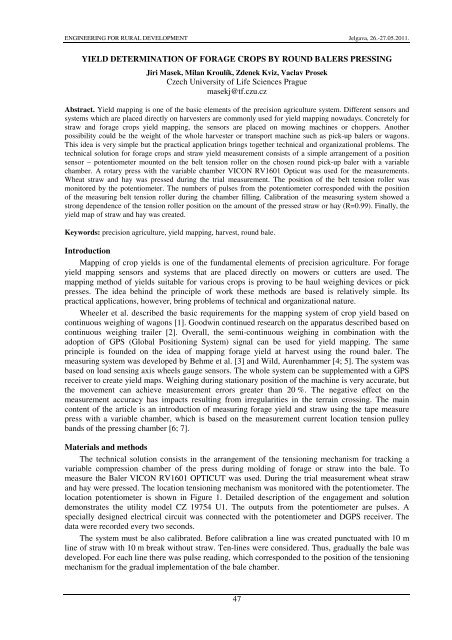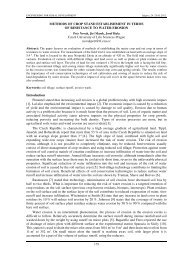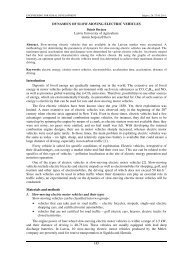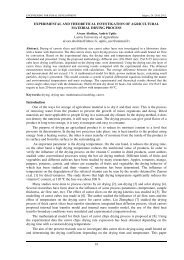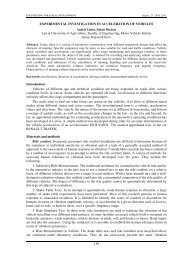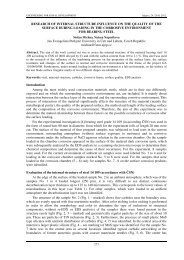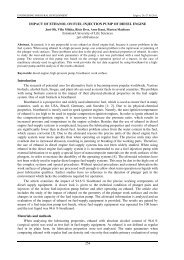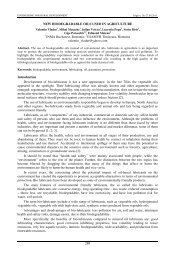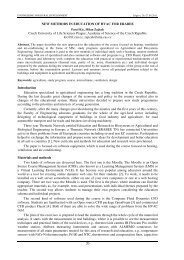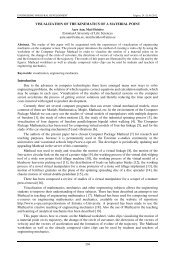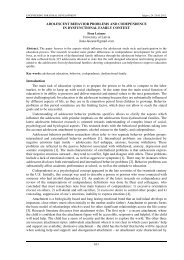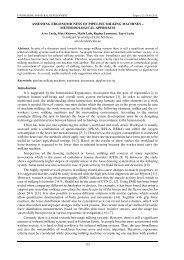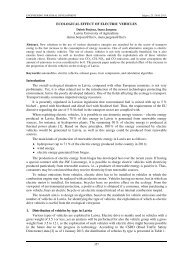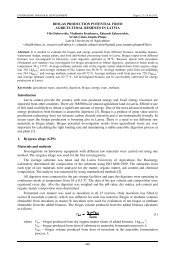Jiri Masek, Milan Kroulik, Zdenek Kviz, Vaclav Prosek Czech ...
Jiri Masek, Milan Kroulik, Zdenek Kviz, Vaclav Prosek Czech ...
Jiri Masek, Milan Kroulik, Zdenek Kviz, Vaclav Prosek Czech ...
You also want an ePaper? Increase the reach of your titles
YUMPU automatically turns print PDFs into web optimized ePapers that Google loves.
ENGINEERING FOR RURAL DEVELOPMENT Jelgava, 26.-27.05.2011.<br />
YIELD DETERMINATION OF FORAGE CROPS BY ROUND BALERS PRESSING<br />
<strong>Jiri</strong> <strong>Masek</strong>, <strong>Milan</strong> Kroulík, <strong>Zdenek</strong> <strong>Kviz</strong>, <strong>Vaclav</strong> <strong>Prosek</strong><br />
<strong>Czech</strong> University of Life Sciences Prague<br />
masekj@tf.czu.cz<br />
Abstract. Yield mapping is one of the basic elements of the precision agriculture system. Different sensors and<br />
systems which are placed directly on harvesters are commonly used for yield mapping nowadays. Concretely for<br />
straw and forage crops yield mapping, the sensors are placed on mowing machines or choppers. Another<br />
possibility could be the weight of the whole harvester or transport machine such as pick-up balers or wagons.<br />
This idea is very simple but the practical application brings together technical and organizational problems. The<br />
technical solution for forage crops and straw yield measurement consists of a simple arrangement of a position<br />
sensor – potentiometer mounted on the belt tension roller on the chosen round pick-up baler with a variable<br />
chamber. A rotary press with the variable chamber VICON RV1601 Opticut was used for the measurements.<br />
Wheat straw and hay was pressed during the trial measurement. The position of the belt tension roller was<br />
monitored by the potentiometer. The numbers of pulses from the potentiometer corresponded with the position<br />
of the measuring belt tension roller during the chamber filling. Calibration of the measuring system showed a<br />
strong dependence of the tension roller position on the amount of the pressed straw or hay (R=0.99). Finally, the<br />
yield map of straw and hay was created.<br />
Keywords: precision agriculture, yield mapping, harvest, round bale.<br />
Introduction<br />
Mapping of crop yields is one of the fundamental elements of precision agriculture. For forage<br />
yield mapping sensors and systems that are placed directly on mowers or cutters are used. The<br />
mapping method of yields suitable for various crops is proving to be haul weighing devices or pick<br />
presses. The idea behind the principle of work these methods are based is relatively simple. Its<br />
practical applications, however, bring problems of technical and organizational nature.<br />
Wheeler et al. described the basic requirements for the mapping system of crop yield based on<br />
continuous weighing of wagons [1]. Goodwin continued research on the apparatus described based on<br />
continuous weighing trailer [2]. Overall, the semi-continuous weighing in combination with the<br />
adoption of GPS (Global Positioning System) signal can be used for yield mapping. The same<br />
principle is founded on the idea of mapping forage yield at harvest using the round baler. The<br />
measuring system was developed by Behme et al. [3] and Wild, Aurenhammer [4; 5]. The system was<br />
based on load sensing axis wheels gauge sensors. The whole system can be supplemented with a GPS<br />
receiver to create yield maps. Weighing during stationary position of the machine is very accurate, but<br />
the movement can achieve measurement errors greater than 20 %. The negative effect on the<br />
measurement accuracy has impacts resulting from irregularities in the terrain crossing. The main<br />
content of the article is an introduction of measuring forage yield and straw using the tape measure<br />
press with a variable chamber, which is based on the measurement current location tension pulley<br />
bands of the pressing chamber [6; 7].<br />
Materials and methods<br />
The technical solution consists in the arrangement of the tensioning mechanism for tracking a<br />
variable compression chamber of the press during molding of forage or straw into the bale. To<br />
measure the Baler VICON RV1601 OPTICUT was used. During the trial measurement wheat straw<br />
and hay were pressed. The location tensioning mechanism was monitored with the potentiometer. The<br />
location potentiometer is shown in Figure 1. Detailed description of the engagement and solution<br />
demonstrates the utility model CZ 19754 U1. The outputs from the potentiometer are pulses. A<br />
specially designed electrical circuit was connected with the potentiometer and DGPS receiver. The<br />
data were recorded every two seconds.<br />
The system must be also calibrated. Before calibration a line was created punctuated with 10 m<br />
line of straw with 10 m break without straw. Ten-lines were considered. Thus, gradually the bale was<br />
developed. For each line there was pulse reading, which corresponded to the position of the tensioning<br />
mechanism for the gradual implementation of the bale chamber.<br />
47
ENGINEERING FOR RURAL DEVELOPMENT Jelgava, 26.-27.05.2011.<br />
By monitoring these parameters the yield maps can be created. Spatially-related data of<br />
throughput of the material were recorded in the data logger. Pulses of a potentiometer and machine<br />
position from DGPS receiver were at the same time recording to the data logger, too. The recording<br />
interval was set to 2 s.<br />
1<br />
2<br />
3<br />
Fig. 1. Location potentiometer on the belt tensioning mechanism: 1 – belt tension roller<br />
mechanism; 2 – connecting rod; 3 – potentiometer<br />
Results and discussion<br />
The trial measurement was carried out in the selected field and started by pressing the arranged<br />
discontinuous row as it was explained above (Fig. 2). This step was taken as a calibration procedure.<br />
Based on the results of the calibration potentiometer the calibration curve was obtained. Depending on<br />
the number of pulses during the potentiometer and net weight of the package best fits the exponential<br />
curve with equation y=2745·1e -0.002x . The graph in Figure 3 shows the calibration curve.<br />
Number of pulses<br />
3000<br />
2500<br />
2000<br />
1500<br />
0 20 40 60 80 100<br />
Time progress, s<br />
Number of pulses<br />
2900<br />
2700<br />
2500<br />
2300<br />
2100<br />
1900<br />
1700<br />
1500<br />
y = 2745.1e -0.002x<br />
R 2 = 0.9994<br />
0 50 100 150 200 250<br />
Weight of bale, kg<br />
Fig. 2. Course of data record during<br />
discontinuous straw row pressing<br />
Fig. 3. Calibration curve<br />
By pressing forage with a variable press chamber machine uniform compressibility of the bale<br />
with increased volume (diameter) of the bale is achieved. The increased volume of the bale recorded<br />
by the potentiometer is proportional to the increasing of the bale weight. Figure 4 shows the time<br />
series record of the measurement of the growth package. For the subsequent processing of each set the<br />
yield t·ha -1 gradually increases. Prior to the processing of the data set it was necessary to exclude<br />
values that were recorded during the tensioning mechanism for returning a package to the starting<br />
position and the value recorded on headlands. Also a point where the package is bound has to be<br />
excluded from the data set. After processing, the record has been found in straw yield values ranging<br />
from 1.5 to 7.3 t·ha -1 with an average of 4.4 t·ha -1 .<br />
48
ENGINEERING FOR RURAL DEVELOPMENT Jelgava, 26.-27.05.2011.<br />
Pulses<br />
2900<br />
2700<br />
2500<br />
2300<br />
2100<br />
1900<br />
1700<br />
1500<br />
0 50 100 150 200 250 300 350 400 450 500<br />
Time progress, s<br />
Fig. 4. Adjusted measured values – number of pulses in time (during real harvest)<br />
The adjusted data were then used for processing by geostatistical methods which demonstrate the<br />
spatial relationships between the measured data. The final graphic output straw yield map was created<br />
by kriging interpolation method (Fig. 5 and Fig. 6).<br />
Straw yield (t·ha -1 )<br />
1.5-2.3<br />
2.3-3.1<br />
3.1-3.9<br />
3.9-4.8<br />
4.8-5.6<br />
5.6-6.4<br />
6.4-7.3<br />
Fig. 5. Yield map of straw<br />
Fig. 6. Yield map of hay<br />
The course of the calibration curves shown in Figure 7 was proved according to our hypotheses<br />
that behaviour of the calibration curves would be dependent on the harvested material. Differences in<br />
49<br />
Hay yield (t·ha -1 )<br />
1.9-2.6<br />
2.6-3.1<br />
3.1-3.4<br />
3.4-3.9<br />
3.9-4.6<br />
4.6-5.4<br />
5.4-6.9
ENGINEERING FOR RURAL DEVELOPMENT Jelgava, 26.-27.05.2011.<br />
bales density and material specific weight influenced the angular coefficient of the curves. On the<br />
other hand, the value range of the sensor output signal remained the same for different materials,<br />
because of the constant final volume of the bale press chamber.<br />
Number of pulses<br />
2900<br />
2700<br />
2500<br />
2300<br />
2100<br />
1900<br />
1700<br />
1500<br />
y = -4.4148x + 2715.5<br />
R 2 = 0.99<br />
y = -2.941x + 2732.5<br />
50<br />
R 2 = 0.99<br />
0 50 100 150 200 250 300 350 400<br />
Weight of bale, kg<br />
Hay<br />
Straw<br />
Fig. 7. Dependence of the number of pulses per bale weight for different materials<br />
The given the amount of the pressed material (by forage production) may be also beneficial<br />
information on the forage yield and useful for precision farming system. Although some generally<br />
known systems presented in the literature review are using it very often in crop production, there has<br />
no extension of any of these principles (for forage yield measurement) as it is in the case of combine<br />
harvesters. One reason may be shortcomings in the systems which also derive from a literature<br />
analysis.<br />
Conclusions<br />
Measurement of the position belt tensioning pulley of the bale press with a variable chamber is<br />
shown as a possible method of evaluating the yield pressed material. Calibration of the measuring<br />
system showed that the principle of measuring the position of the belt tensioning pulley was not<br />
sensitive to shocks. The big advantage of this solution is a simple construction. On the other hand,<br />
there is a limiting factor essential for the type of the press with a variable pressing chamber. The<br />
outcome will certainly affect the kind of the pressed material and its compressibility. From this<br />
perspective calibration is needed before harvesting.<br />
Acknowledgements<br />
Supported by Ministry of Education, Youth and Sports of the <strong>Czech</strong> Republic, Project No. MSM<br />
604 607 0905.<br />
References<br />
1. Behme J.A. et al. Site-Specific Yield for Forages. ASAE Paper No. 97-1054. St. Joseph,<br />
Michigan, ASAE, 1997.<br />
2. Kroulík M., Mašek J., Heřmánek, P., Kumhála, F. Zapojení snímačů pro zjišťování průchodnosti<br />
píce ve svinovacím lisu s variabilní komorou. ÚPV No CZ 19754 U1, reg. 02.04.2009.<br />
3. Goodwin R. J. et al. Cumulative mass determination for yield maps of non-grain crops.<br />
Computers and Electronics in Agriculture 23/1999, Elsevier Sciences, pp. 85-101<br />
4. Wheeler P., et al. Trailer Based Yield Mapping. Precision Agriculture 1997, BIOS Scientific<br />
Publishers Ltd, pp. 751-758<br />
5. Wild K. Auernhammer, H. Dynamic Weighing in a Round Baler for Local Yield Measurement.<br />
ASAE Paper No. 97-1055. St. Joseph, Michigan, ASAE, 1997.<br />
6. Wild K., Auernhammer H. A weighing system for local yield monitoring of forage crops in round<br />
balers. Computers and Electronics in Agriculture 23/1999, Elsevier Sciences, pp. 119-132<br />
7. Kroulík M., Mašek J., Kvíz Z., Prošek V. Sensor connection for yield determination on round<br />
balers with variable chamber. Landtechnik 2010, VDI Verlag: Düsseldorf, pp. 231-237, ISBN<br />
978-3-18-092111-2.


